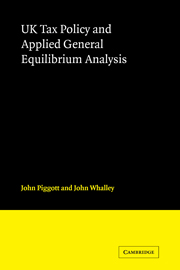Book contents
- Frontmatter
- Contents
- PREFACE
- ACKNOWLEDGEMENTS
- INTRODUCTION AND SUMMARY OF STUDY
- PART I The General Equilibrium Model of the UK – Structure, Data and Model Solution.
- PART II Empirical Analysis of the UK Tax/Subsidy System Using the General Equilibrium Model
- SUMMARY AND CONCLUSIONS
- APPENDIX A Structure of the Basic Variant Model
- APPENDIX B Notes to Tables Appearing in Chapter 5
- APPENDIX C Notes on Programming and Computation
- BIBLIOGRAPHY
PART II - Empirical Analysis of the UK Tax/Subsidy System Using the General Equilibrium Model
Published online by Cambridge University Press: 04 August 2010
- Frontmatter
- Contents
- PREFACE
- ACKNOWLEDGEMENTS
- INTRODUCTION AND SUMMARY OF STUDY
- PART I The General Equilibrium Model of the UK – Structure, Data and Model Solution.
- PART II Empirical Analysis of the UK Tax/Subsidy System Using the General Equilibrium Model
- SUMMARY AND CONCLUSIONS
- APPENDIX A Structure of the Basic Variant Model
- APPENDIX B Notes to Tables Appearing in Chapter 5
- APPENDIX C Notes on Programming and Computation
- BIBLIOGRAPHY
Summary
Introduction
In this part of the monograph we report our findings on the allocative and redistributive effects of the UK tax/subsidy system using the model described in preceding chapters. We simulate a number of counterfactual equilibria for the economy under alternative policies from those associated with the 1973 benchmark equilibrium. We compare counterfactual and the benchmark equilibria to arrive at our evaluation of the impacts of the tax/subsidy system.
In these comparisons we concentrate on various summary indices. In our welfare analysis we stress Hicksian compensating and equivalent variations. The compensating variation (CV) for a single household is the sum of money that would need to be taken away from a household so as to restore its original utility level prevailing before the change. The Hicksian equivalent variation (EV) is the sum of money which would need to be given to a household to increase its welfare to a level equivalent to that which it would have enjoyed had some proposed policy change been enacted. The compensating variation is a measure at the new equilibrium prices; the equivalent variation is measured at the prechange prices. These definitions imply that a positive equivalent or compensating variation indicates a welfare gain from moving to the counterfactual equilibrium from the benchmark. As Kay [1980] points out, in a sequence of wise comparisons between alternative counterfactual equilibria and the same benchmark equilibrium, the sequence of comparisons using EV's uses the same price data, since the EV is based on original benchmark prices.
- Type
- Chapter
- Information
- UK Tax Policy and Applied General Equilibrium Analysis , pp. 181 - 183Publisher: Cambridge University PressPrint publication year: 1985



